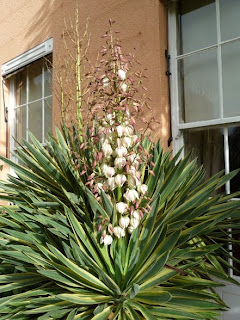Our last great house, Lanhydrock, in western Cornwall, was in many ways our best. (All the great houses close by November 1). It is by no means the largest, the most historic, the best art or best gardens. It does have 50 rooms open to the public, more than any other, completely furnished as it was in the high Victorian era, the best kitchen and servants areas we have seen, and a family, particularly in Victorian and Edwardian times, you come to care about. The house itself was begun in the mid 17th century. Most of the furnishings, as I said, are Victorian or slightly later.
Lanhyrock was among the Robartes family's vast holdings, including a great house in London, Wimpole House (our first great house, way back in August), and something on the order of 100,000 acres, with all the usual farms, villages, houses, etc. Cornwall's richest family. By Victorian times, they had gotten into politics, as members of the House of Commons and prominent Liberals, into temperance and social reform. The heir and great hope of the family was "Tommy" Robartes, whom the Conservatives didn't even challenge in elections. Tommy enlisted in 1914, insisted on being at the front lines, and died at Loos in 1915, of wounds incurred in No Man's Land, saving one of his men. Next in line also did not survive the war, and the last brother, Arthur, evenutally donated it all to the National Trust.
The family was devastated by Tommy's death. His rooms were closed and not re-opened until the house came to the Trust in the 1970s. His suitcase appears just as it was when it was returned from France. Sad and moving.
The most impressive room in the house is the great hall, mid-17th century, perhaps 150 feet long, now a library/music/art room, but covered by incredibly detailed vaulted ceiling with reliefs depicting scenes from the Bible. We were so taken with Lanhydrock that we closed the place, more or less, too late to find any better camping than the local rugby club's carpark.
 |
Sometimes, just getting to a site can be a challenge; here we
are about to cross an ancient twisty bridge over a serious river;
the bridge is exactly 7 feet wide; the Grey Wanderer is 6 foot
eight inches, not including mirrors; but we made it |
 |
The gatehouse; was the original building, an
Elizabethan hunting "cabin"
|
 |
Lanhydrock, from the entry gatehouse
|
 |
Earliest date on the house
|
 |
In the kitchen area (half a dozen large rooms), the largest
spit we have yet seen...9 feet across
|
 |
Olympic-sized billiard table
|
 |
The childrens' rooms were incredible; this is their classroom
|
 |
About 1/3 of the drawing room
|
 |
The attached parish church
|
 |
Formal gardens
|
 |
More gardens
|
 |
Family chair from Queen Elizabeth's
coronation
|
 |
Last of the line
|
Vicki adds:
Swindon, England November 7, 2009
I wanted to tell the story of a woman I met last week in the campground in Plymouth. She was sitting in the bathroom reading when I went to take a shower. Since that is pretty unusual she explained that she was tent camping and it was much warmer to sit in the bathroom plus there was better light. I asked her where she was from and she said Albany, New York. Now I know that most of our friends and relatives think we are terribly adventurous (which we are not really) compared to many others that we meet. This lady was nearing sixty, about 30 lbs heavier than I, single and has been traveling the world for almost ten years. She told me that she had been a medical transcriptionist but upon reaching her fifties found that no one would hire her, so she decided she could live as cheaply traveling as staying put. Early on she carried a backpack and stayed in hostels, but her shoulders won't manage a heavy pack anymore and the hostels have become too expensive. So now she travels mostly by bus with a wheely duffel and stays in campgrounds. She spends her days going on walks that she can reach through public busses.. She had just finished 4 months in England doing most of the footpaths in the two national parks, Dartmoor and Exmoor, in southwestern England and was taking the ferry to Portugal the next day. She spends 3 months a year in Albany taking care of her elderly mother while her sister travels.
Anyway I was just floored. I guess where there is a will, there is a way. But I can't imagine being that adventurous.



















































